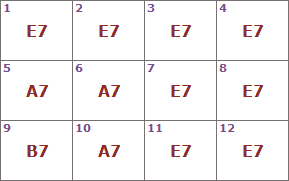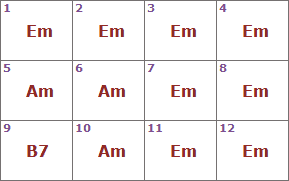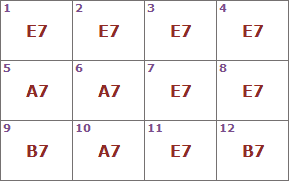12-bar blues
The 12-bar is an extremely common structure when playing blues. As the name implies, the 12-bar blues are twelve bars in a given arrangement that are repeated through a song. There are plenty of arrangements, based on chord progressions, to use.
The 12-bar blues is commonly written out by the chords that are used. You can also play scales over these chords.
Standard 12-bar blues
The following structure is one of the most common and is fundamental knowledge for blues.

The numbers are just to illustrate the order of bars. You could, for instance, play with four beats per bar like this:
(1) E7 / / / - (2) E7 / / / - (3) E7 / / / - (4) E7 / / / -
(5) A7 / / / - (6) A7 / / / - (7) E7 / / / - (8) E7 / / / -
(9) B7 / / / - (10) A7 / / / - (11) E7 / / / - (12) E7 / / /
In the key of C, the chords would instead be C7, F7 and G7. See Appendix A for standard 12-bar blues in all keys.
12 Bar Blues in E sound example. The 12 bar section are played two times with turnarounds in the last measure the first time.
As a suggestion, use the E Pentatonic Minor Blues and/or the E Pentatonic Major Blues scales to improvise over the 12-bar blues track.


Playing scales over the 12-bar blues
You can either play one scale over all bars or change scale as the chord change. In addition, it is a common method to put extra empathize on tones included in the actual chord that is being played. You need to develop your ear for this. Try to play the chords with your left hand and notes from the scale with your right.
12-bar blues in minor
The following structure replicates more or less, the previous structure, but is based on minor:

You could, for instance, play with four beats per bar like this:
(1) Em / / / - (2) Em / / / - (3) Em / / / - (4) Em / / / -
(5) Am / / / - (6) Am / / / - (7) Em / / / - (8) Em / / / -
(9) B7 / / / - (10) Am / / / - (11) Em / / / - (12) Em / / /
12 Bar Blues in Em sound example. The 12 bar section are played two times with turnarounds in the last measure the first time.
For improvising over this 12-bar blues, you can use the Em Pentatonic Blues Scale.

As already said, there are endless ways to vary the twelve bars (it must not necessarily be 12 bars, the 16-bar blues structure is also popular). Also to be familiar with, when learning the 12-bar structure, is the turnaround as in the next example. See Appendix B for standard 12-bar minor blues in all keys.
12-bar blues with turnaround
A turnaround is a key feature of the blues, creating a transition back to the start of the progression. The following example include a turnaround in the last bar.

The novelties are only at the end: in the last two bars you should play five measures of the E7 chord and then change to B7 for the last three before returning to the top of the form.
(1) E7 / / / - (2) E7 / / / - (3) E7 / / / - (4) E7 / / / -
(5) A7 / / / - (6) A7 / / / - (7) E7 / / / - (8) E7 / / / -
(9) B7 / / / - (10) A7 / / / - (11) E7 / / / - (12) / B7 / /
The last time the structure is played in the song, it should end on an E chord.
12-bar jazz-blues
This example jumps into a more complex progression by some extra chords added to the 12-bar structure. As a result, we got a mix of blues and jazz.

A more detailed presentation, including measures in the bars:
(1) C7 / / / - (2) F7 / / / - (3) C7 / / / - (4) C7 / / / -
(5) F7 / / / - (6) F7 / / / - (7) C7 / / / - (8) A7 / / / -
(9) Dm7 / / / - (10) G7 / / / - (11) Em7 / / / - (12) Dm7 / G7 /
In this example, some extra chords were added to the 12-bar structure and as a result we got a mix of blues and jazz.
8-bar ragtime
The 8-bar progression is an alternative to the 12-bar version. The 8-bar is often used in ragtime, which you can see an example of below:
(1) C / / / - (2) E7 / / / - (3) A7 / / / - (4) / / / / -
(5) D7 / / / - (6) G7 / / / - (7) C / / / - (8) G7 / / / -
Notice how this progression is based on the descending fifth intervals.
Appendix A
The I, IV and V chords as in the standard 12-bar blues in all keys.
| I | IV | V |
|---|---|---|
| A7 | D7 | E7 |
| A#7 / Bb7 | D#7 / Eb7 | F7 |
| B7 | E7 | F#7 |
| C7 | F7 | G7 |
| C#7 / Db7 | F#7 / Gb7 | G#7 / Ab7 |
| D7 | G7 | A7 |
| D#7 / Eb7 | G#7 / Ab7 | A#7 / Bb7 |
| E7 | A7 | B7 |
| F7 | Bb7 | C7 |
| F#7 / Gb7 | B7 | C#7 / Db7 |
| G7 | C7 | D7 |
| G#7 / Ab7 | C#7 / Db7 | D#7 / Eb7 |
It is common to play seventh chords in blues, but it is possible to substitute them for ninth chords.
Appendix B
The I, IV and V chords as in the standard 12-bar blues in all minor keys.
| I | IV | V |
|---|---|---|
| Am | Dm | E7 |
| A#m / Bbm | D#m / Ebm | F7 |
| Bm | Em | F#7 |
| Cm | Fm | G7 |
| C#m / Dbm | F#m / Gbm | G#7 / Ab7 |
| Dm | Gm | A7 |
| D#m / Ebm | G#m / Abm | A#7 / Bb7 |
| Em | Am | B7 |
| Fm | Bbm | C7 |
| F#m / Gbm | Bm | C#7 / Db7 |
| Gm | Cm | D7 |
| G#m / Abm | C#m / Dbm | D#7 / Eb7 |
The minor triads can be substituted for minor seventh chords.